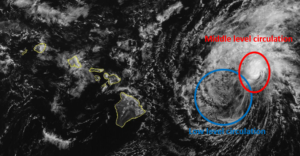Former Tropical Storm Gil strengthened to a hurricane over the Eastern North Pacific Ocean southwest of Baja California on Friday. At 11:00 p.m. EDT on Friday the center of Hurricane Gil was located at latitude 16.5°N and longitude 125.1°W which put the center about 1080 miles (1740 km) west-southwest of the southern tip of Baja California. Gil was moving toward the west-northwest at 20 m.p.h. (32 km/h). The maximum sustained wind speed was 75 m.p.h. (120 km/h) and there were wind gusts to 90 m.p.h. (145 km/h). The minimum surface pressure was 991 mb.
Former Tropical Storm Gil strengthened to a hurricane on Friday. The inner end of a rainband wrapped around the western and southern sides of the center of Gil’s circulation. Bands of showers and thunderstorms were revolving around the center of Hurricane Gil. Storms near the center of Gil generated upper level divergence that pumped mass away from the hurricane. The removal of mass caused the surface pressure to decrease.
The strongest winds were occurring in the northeastern part of Hurricane Gil. Winds to hurricane force extended out 25 miles (40 km) in the northeastern quadrant of Gil’s circulation. Winds to tropical storm force extended out 125 miles (200 km) from the center of Hurricane Gil.
Hurricane Gil will move through an environment somewhat favorable for intensification during the next 24 hours. Gil will move over water where the Sea Surface Temperatures are near 27°C. It will move through a region where there will be little vertical wind shear. However, Gil will move into a region where there is very dry air. The dry air will inhibit intensification. Hurricane Gil could intensify during the next 24 hours if the dry air does not penetrate to the core of Gil’s circulation.
Hurricane Gil will move around the southern side of a high pressure system over the Eastern North Pacific Ocean. The high pressure system will steer Gil toward the west-northwest during the next 24 hours. On its anticipated track, Hurricane Gil will continue to move farther away from Baja California.
Elsewhere, former Tropical Storm Iona weakened to a tropical depression as it approached the International Date Line. At 11:00 p.m. EDT on Friday the center of Tropical Depression Iona was located at latitude 15.8°N and longitude 179.5°W which put the center about 1465 miles (2355 km) west of Honolulu, Hawaii. Iona was moving toward the west-northwest at 17 m.p.h. (28 km/h). The maximum sustained wind speed was 35 m.p.h. (55 km/h) and there were wind gusts to 45 m.p.h. (75 km/h). The minimum surface pressure was 1008 mb.

